How To Write Website Content That Will Produce Higher Earnings
Publishers often understand that website content is king. What’s more, it’s easy to see that certain types of content produce a lot higher ad earnings than others. However, it’s always a surprise to learn that the vast majority of publishers actually wrongly attribute their highest earning website content to the wrong pages and types of content that they produce.
If you’re a website content creator, you’ve likely already nailed down what pages on your website perform the best and earn the most money or have been told this by members of your leadership team.
Publishers generally assess website content profitability using page RPMs (revenue per mille [thousand] impressions), which measures how much money a single page is making per 1,000 ad impressions (the total of all the CPMs on the page — individual ad value).
Below, I’ll demonstrate how publishers can write website content that will produce higher earnings using their existing content and data about their audience that is likely being ignored.
[This metric is referred to as earnings per thousand (mille) visitors, or EPMV. You can read here.]
Why do most publishers wrongly identify their highest earning pages?
Usually, publishers miss out on which content is earning them the most money because they are too focused on organic keywords and trending topics when they are creating content and then too focused on CPMs or RPMs when measuring the value of pages.
In reality, If you’re able to decipher which of your landing pages are bringing in the most traffic and revenue per session, you can create similar content that generates higher revenue even faster for your website.
This means that you can increase your website earnings and traffic faster by combining EPMV research with your existing trending topics or keyword research.
Watch me explain how to quickly identify that high earning content in Ezoic Explains.
Why RPMs don’t show which website content earns the most money
Let’s start by understanding what that mystery info in the graphic above could be. How could a page with a 50% higher RPM actually earn less each month than a page that only produces a $10 RPM? There’s no way that can make sense, right?
This actually is possible and happens on every website. The difference is that you have to begin thinking in terms of LANDING PAGES, not PAGES. And, instead of thinking of RPMs we have to begin thinking about the total revenue generated per session/visit.
To demonstrate the importance of total session revenue vs. page revenue, let’s imagine we have a car website that has page RPMs equivalent to our example above.
Example: These four pages are the top landing pages of the website (or the pages people land on first when they come to on the website). For this site, these are landing pages from organic search results for keywords the publisher ranks for in Google’s search engine.
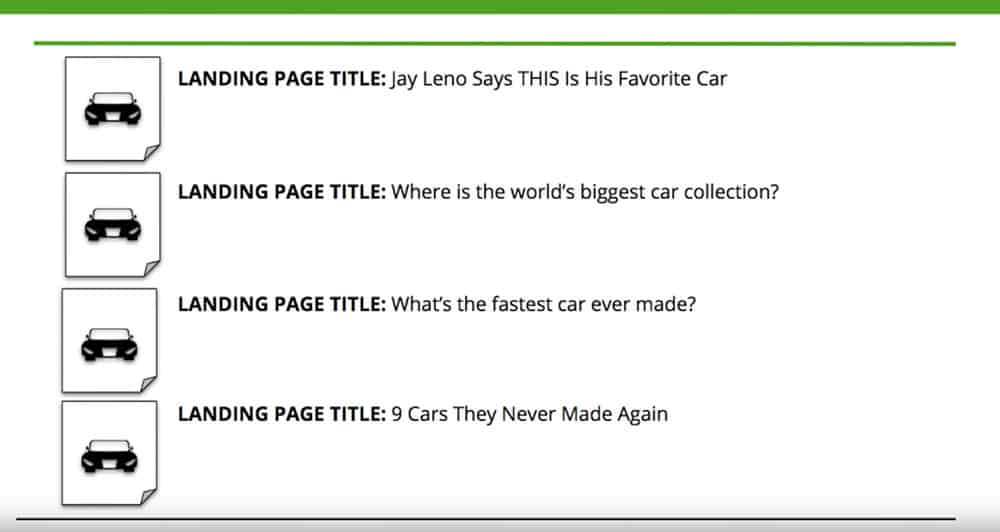
Looking at page RPMs — like many ad operations pro’s or outsourced ad providers do — we can see that the landing page about Jay Leno has the highest RPM (potentially because of the celebrity context on that page). This often leads to the misunderstanding that the landing page about Jay Leno is producing more revenue than the other landing pages.
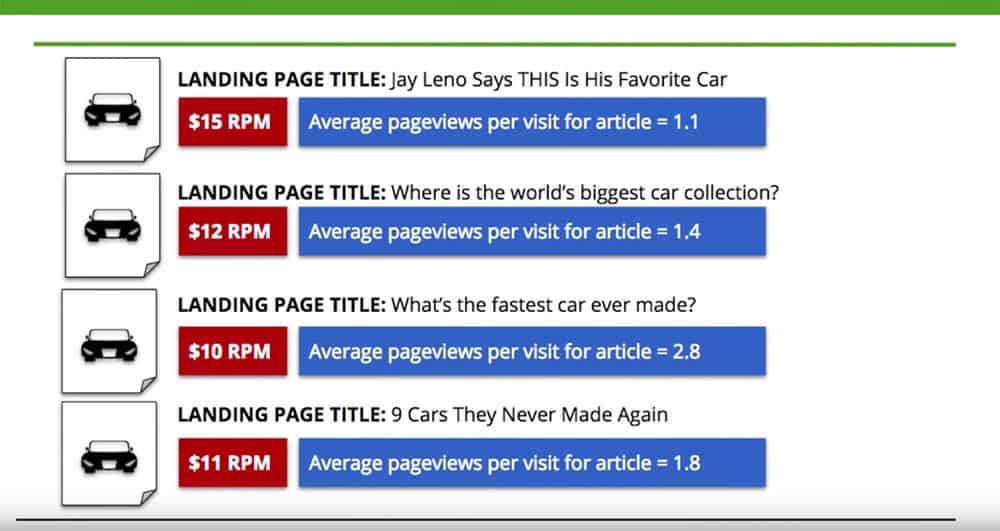
This is where publishers’ focus is on the wrong set of data.
While the Jay Leno article has the highest RPM at $15 and the fastest car article has the lowest RPM at $10, the number of pages a visitor views after landing on each article is quite different.
This behavior dramatically impacts ad earnings at the end of the month
Pageviews per visit represent the mystery info in the graphic at the very top. This behavior affects the amount of revenue you make per visitor, but not per page.
At the end of the month, when a publisher looks at their overall website revenue they won’t care about which pages produced the highest RPMs. They will care about how much money the site made total. The only way to know that you are making more money from traffic each month than you were the previous month is to make more money per visitor… not per page.
Visitors that land on the Jay Leno article only averaged 1.1 pageviews, which means that landing page only makes $16.50 per one thousand visitors (EPMV). Those who land on the fastest car article, however, average 2.8 pageviews, which equates to $28.00 per one thousand visitors.
The page with lower page RPM generates 70% higher ad earnings per visit.
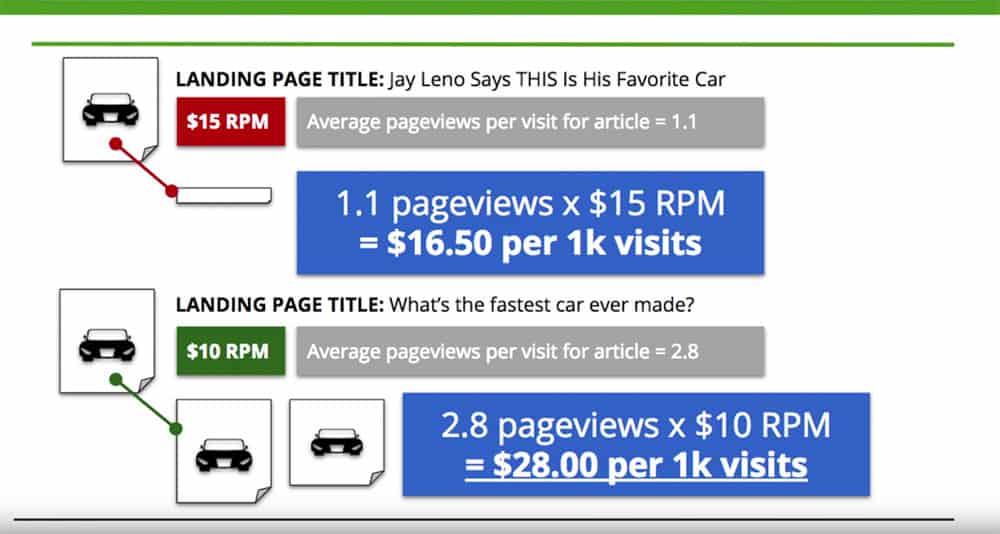
This is why looking at revenue per session rather than per page is so important — it gives you a totally different view of your content and your visitors.
In this example, if you were to optimize for RPMs, you would be leaving a lot of money on the table in the long run. In fact, the ladning page with the lower page RPM actually produces 70% more revenue per visit than the Jay Leno landing page with a 50% higher RPM!
We’ve discussed how RPMs can generate lower ad revenue before in a blog post about ad density and ad thresholds.
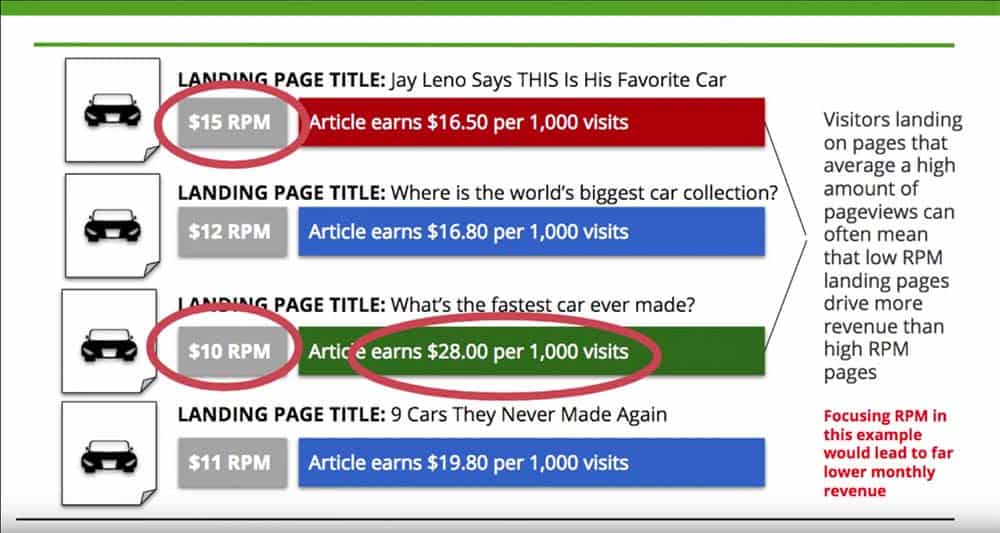
Instead of focusing on which page generates the highest earning ad impressions on average, we should be concerned with which landing pages produce the highest earning visits on average.
If a publisher can produce more content that generates additional pageviews like their highest performing landing pages today — or simply optimizes for EPMV instead of RPMs — they can effectively produce far more revenue by simply using better data.
How to use Ezoic’s Big Data Analytics to determine landing page EPMV
Ezoic customers can use Big Data Analytics to easily see which of their landing pages are the most profitable per session.
Under Content, navigate to Landing Pages. From here, you can add a filter to only see pages with a steady flow of traffic (you can set whatever threshold you think is meaningful for your website).
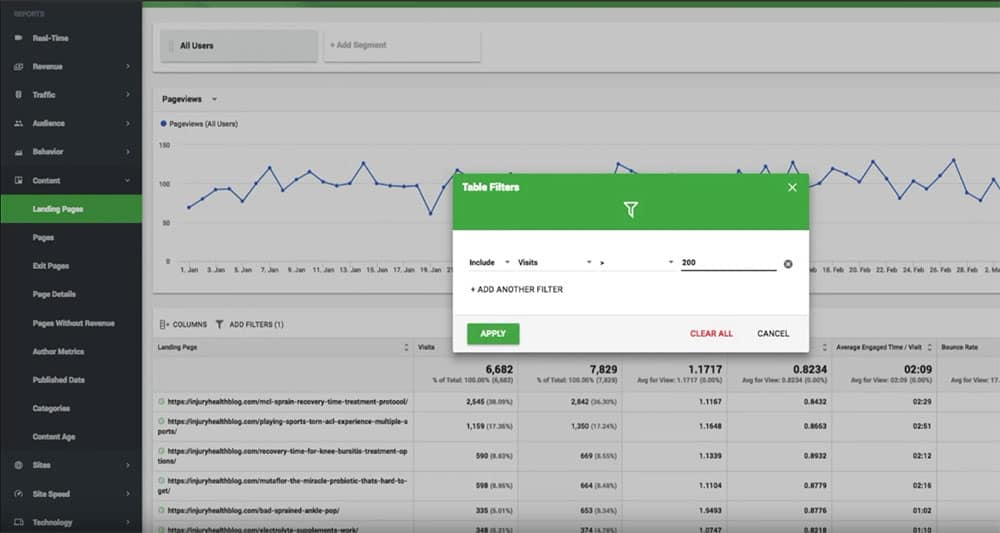
Once you apply the filter, you can drag and drop the EPMV column next to the landing pages to see which landing page is earning an above-average EPMV. Then, sort by which ones have the highest average.
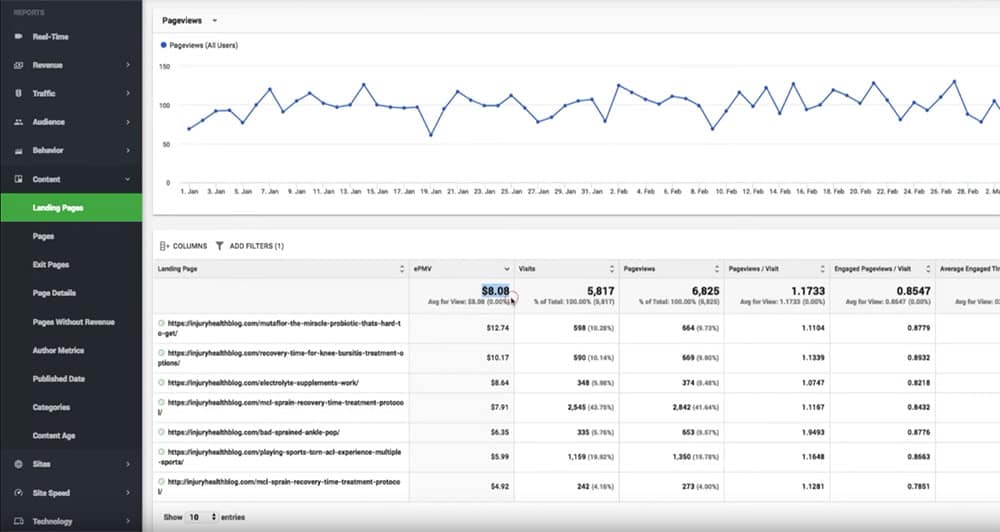
Here, we can see that there are three pages on this small blog that generate higher EPMVs than average. These are the pages we would want to focus on and figure out why they tend to bring in more money over time.
From there, we can begin to work on similar content to these top-earning landing pages and accrue more revenue.
You can also do this in Google Analytics by combing landing page session information with landing page revenue reports from AdSense, Google AD Manager (DFP), or any other networks you use.
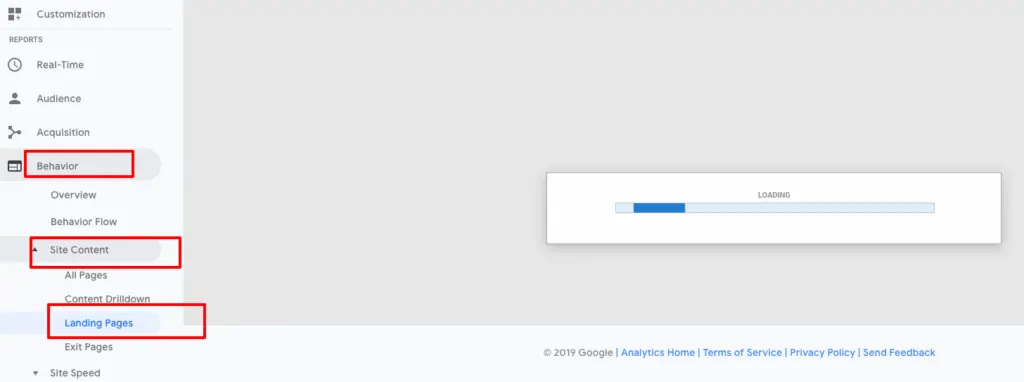
Simply take the sessions per landing page and match them with the landing page revenue to get the total revenue per landing page, multiply by the average pageviews per visit for those landing pages, and then divide by 1,000 to get the average EPMV.
How do you write more website content like your highest earning content?
To generate content like your highest earning content, you have to first identify the landing pages with the highest session revenue (EPMV). Once you’ve done this you can examine those topics and apply some simple keyword research to help you craft similar content that can link to pages in the same fashion that your highest earning EPMV content does. See above.
There are two simple ways to do this…
- Using SEMRush or another paid keyword research tool
- Using Google Search for free
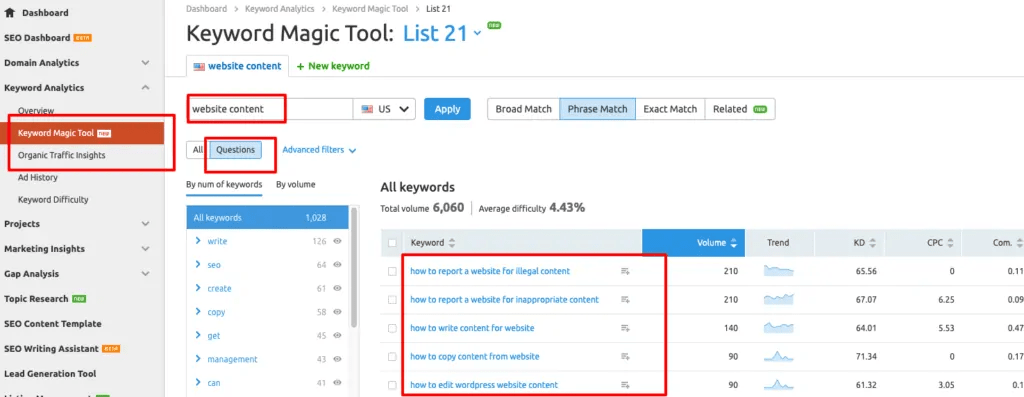
Using a paid keyword research tool is pretty straightforward. Use the tool to find related questions or phrases that may allow you to pick-out subjects that your website could write about that would link well to the existing high-earning landing pages and the pages that they link to.
Simply use the tool to write content that applies to the topic you’ve found. Then, at the top of that page and throughout the content, try to link to the pages associated with your existing content that is already producing a high EPMV.
How can you use Google Search to do some of this content research for free?
While it may not always be as comprehensive or as applicable as some of the paid tools, publishers can hack Google’s search engine to provide some pretty helpful content creation ideas as well.
This works even better if your content is query-based — meaning that it is based on a question that a potential searcher might ask…
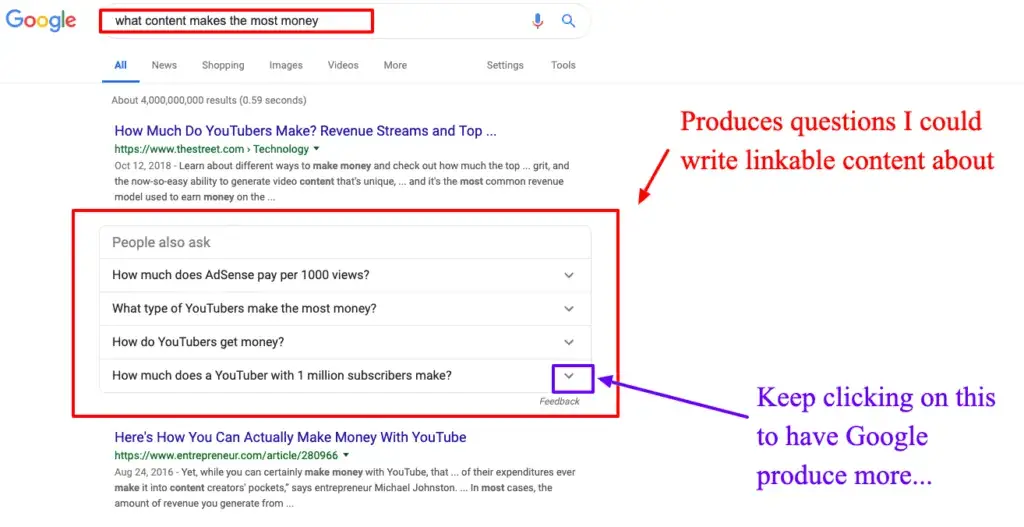
Try searching some of the keywords, associated questions, or topics related to your highest earning landing page in Google Search in the form of a question someone might ask about them.
This will likely produce some of the Google “people also ask” rich results. You can use these queries to formulate content ideas that could easily link to your high earning content and pages that the high earning content already links to.
Additionally, you can keep clicking on the results inside of the “people also ask” widgets to have Google continue populating these results with more potential topics and questions. You may want to write additional articles on these topics or try combining them together to produce really good high-quality content that links out to all of you highest earning landing pages on that particular subject.
Why data can help you create better content that earns more money
Most publishers focus on the wrong data when they attempt to create content that earns more ad revenue. While topics, your existing audience, and the site’s popularity will determine a lot about how much your site can earn from ads, the behavior of visitors on your landing pages is one of the easiest things for you to control as a publisher.
Using data to understand which landing pages are earning the most and then leveraging keyword research to write more content that is similar can be an effective strategy for increasing overall website ad earnings.
Questions? Leave a comment below and I’ll provide further insight if I can.


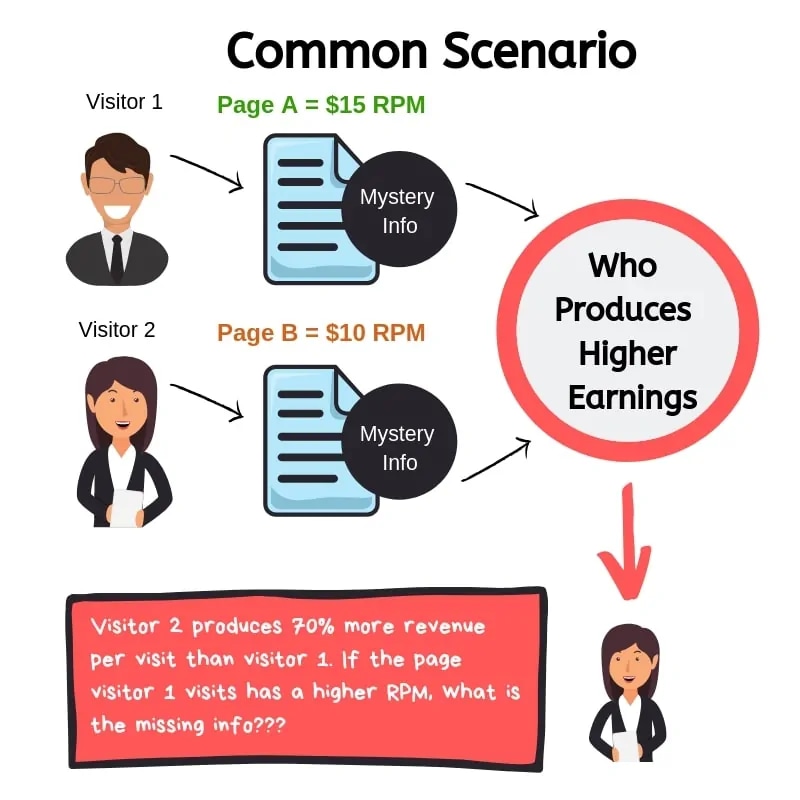
Thank you, Tyler!
I understand the concept. In your scenario, you assume that all subsequent pages have the same RPM.
Assuming the landing page with higher RPMV have proper internal links, what would happen if you link to the pages with high RPMs?
I once read an article about how Ezoic AI shows different ads based on first page or second page of visit.
Thank you, Tyler!
I understand the concept. In your scenario, you assume that all subsequent pages have the same RPM.
Assuming the landing page with higher RPMV have proper internal links, what would happen if you link to the pages with high RPMs?
I once read an article about how Ezoic AI shows different ads based on first page or second page of visit.
Pierre, absolutely correct. In the scenarios here we assume subsequent pages have the same RPM as the landing page. It furthers the point that RPM is not a great metric for optimizing revenue; however, in reality looking at ACTUAL session EPMV is going to be far more valuable than estimations with avg. page RPMs being calculated.
And yes, that is the premise behind Ezoic’s Ad Tester. It essentially uses machine learning to understand how visitors behave and then alters the ad placements and density to balance session length and pageviews alongside ad revenue to maximize earnings while balancing user experiences for each individual visitor.
Pierre, absolutely correct. In the scenarios here we assume subsequent pages have the same RPM as the landing page. It furthers the point that RPM is not a great metric for optimizing revenue; however, in reality looking at ACTUAL session EPMV is going to be far more valuable than estimations with avg. page RPMs being calculated.
And yes, that is the premise behind Ezoic’s Ad Tester. It essentially uses machine learning to understand how visitors behave and then alters the ad placements and density to balance session length and pageviews alongside ad revenue to maximize earnings while balancing user experiences for each individual visitor.
Thank you for this information… I will use it to improve my website earnings
Thank you for this information… I will use it to improve my website earnings
Awesome.. blog post thank you for contribute.
Awesome.. blog post thank you for contribute.
Very good!Thanks!
Very good!Thanks!
Wonderful…post. Thanks for sharing.
Wonderful…post. Thanks for sharing.
Wonderful information
Wonderful information
Awesome article!! This was a sponsored ad on FB btw. I rarely read these and think they are good.
Awesome article!! This was a sponsored ad on FB btw. I rarely read these and think they are good.
Nice article. I really loved it. Thanks for this post.
Nice article. I really loved it. Thanks for this post.
Hi Tyler,
Is it possible to determine EPMV using Google Analytics? They certainly do not have this measurement, but I tried identifying EPMVs based on actual RPMs of each subsequent page using behavioral flow. However, it becomes really messy with all the flows and different data.
Do you know if there’s an easier way?
Thank you,
Rokas
Hi Tyler,
Is it possible to determine EPMV using Google Analytics? They certainly do not have this measurement, but I tried identifying EPMVs based on actual RPMs of each subsequent page using behavioral flow. However, it becomes really messy with all the flows and different data.
Do you know if there’s an easier way?
Thank you,
Rokas
Unfortunately, the best way to do it is by taking the average RPM of pages and using the top landing pages and their pageviews per session as a multiple. This isn’t as accurate, unfortunately, if you’re solely using GA. It is easy to determine EPMV at a macro level site-wide. But, the landing page EPMV is what makes content truly valuable.
If you have total revenue reporting in AdSense or Ad Manager connected to Analytics, you could look at Behavior > Site Content > Landing Pages and then look at the revenue for just those sessions — by landing page and then divide the revenue by the total number of just those sessions.
Unfortunately, the best way to do it is by taking the average RPM of pages and using the top landing pages and their pageviews per session as a multiple. This isn’t as accurate, unfortunately, if you’re solely using GA. It is easy to determine EPMV at a macro level site-wide. But, the landing page EPMV is what makes content truly valuable.
If you have total revenue reporting in AdSense or Ad Manager connected to Analytics, you could look at Behavior > Site Content > Landing Pages and then look at the revenue for just those sessions — by landing page and then divide the revenue by the total number of just those sessions.
Pretty nice. But I have a question? Have you heard anything about “power writing” – the last time I heard “copywriting dies” and power writing is currently important – or understanding the content by the user. Aside the correctness of spelling goes away, it is important that the user quickly and understand read content
Pretty nice. But I have a question? Have you heard anything about “power writing” – the last time I heard “copywriting dies” and power writing is currently important – or understanding the content by the user. Aside the correctness of spelling goes away, it is important that the user quickly and understand read content
Power writing is a good concept. I think it is a model like any other. Certain audiences will respond better than others.
Power writing is a good concept. I think it is a model like any other. Certain audiences will respond better than others.
Yes it’s true about powerwriting. People do not have time to read long texts, so a sentence should contain about 10-15 words to make it understandable for an ordinary user. Longer texts can be cured or the user will wait when he reaches the dot and forget about what he read. So it seems to me that the addition of phones and limitations of resolution imposes the writing of short and understandable texts.
Yes it’s true about powerwriting. People do not have time to read long texts, so a sentence should contain about 10-15 words to make it understandable for an ordinary user. Longer texts can be cured or the user will wait when he reaches the dot and forget about what he read. So it seems to me that the addition of phones and limitations of resolution imposes the writing of short and understandable texts.
Hi,
I was looking for such a detailed guide to understand my own findings and to me, we should stay in a niche and gradually pick the next niche after publishing enough articles for the first niche.
And I believe that the landing page or the homepage should be clear about your content and should represent the whole niche (categories) of your blog and that’s all.
Thanks!
Hi,
I was looking for such a detailed guide to understand my own findings and to me, we should stay in a niche and gradually pick the next niche after publishing enough articles for the first niche.
And I believe that the landing page or the homepage should be clear about your content and should represent the whole niche (categories) of your blog and that’s all.
Thanks!
Awesome article!! Thank you for this information… I will use it to improve my websites earnings, I really loved it. Thanks for this post.
Awesome article!! Thank you for this information… I will use it to improve my websites earnings, I really loved it. Thanks for this post.